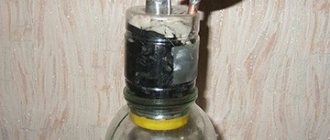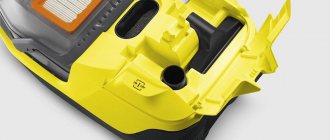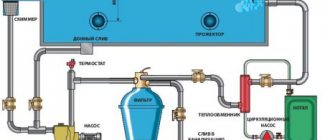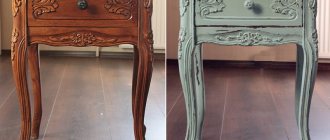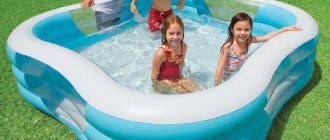Does your pool, in addition to the joy of bathing and swimming, cause you trouble in the form of quickly polluted water? Did the cost of filters for cleaning it, which are offered in specialized stores, shock you? Agree, it would be nice to get a filter device for a reasonable price.
You don't have to buy expensive devices for this. You can make an effective sand filter for your pool with your own hands, which will adequately purify the water from foreign matter. We will help you cope with this task - the article provides step-by-step instructions on how to make such a filter on your own.
We provided the construction process with visual photographs and videos on how to independently create simple and effective filter devices.
Does the pool need to be equipped with a filter?
Owners of small inflatable and stationary pools often do not think about water purification. After bathing, it is simply used for household needs and watering the garden.
If necessary, fill the container again with clean water. However, this method is justified only for very small inflatable pools.
Without proper care, the water column itself becomes polluted and microorganisms and bacteria settle in it. Algae gives the liquid an unpleasant odor and green color. Swimming in such a pool becomes dangerous
But even with them there is enough hassle - the water becomes polluted after the first bath. After draining the liquid, the surface must be washed and filled with clean water, which must still warm up. But in hot weather you want to swim more than once - children, for example, splash there all the time.
In addition to the pollution caused by humans, various natural pollutants also constantly enter stagnant water, these are:
- leaves and grass;
- dust;
- bird droppings;
- plant pollen.
Large and light debris is removed from the surface of the pool with nets, and particles settled to the bottom are removed with a water vacuum cleaner.
However, many substances dissolve or remain suspended in water. Under the influence of sunlight and atmospheric oxygen, bacteria and microorganisms begin to actively multiply in such a liquid. It begins to emit an unpleasant odor, bloom and can cause poisoning and serious illnesses.
Therefore, it is necessary to clean not only the surface and sedimentary formations, but also the water column itself. An effective way to keep water in good condition at all times is to include an effective filter in the water supply system.
Installing a filter for water treatment in a pool allows you to maintain proper sanitary and hygienic condition of the bowl and relieves swimmers from a number of diseases
Manufacturers
Comparison table of various companies producing sand filters:
| Brand name | Main country of production | Year of foundation | Products offered | Price range (RUB) |
| Bestway | China | 1994 | Filter pumps with a capacity from 2006 to 11355 l/h for above-ground swimming pools | 2200-15500 |
| Intex | 1966 | Filter pumps Krystal Clear, ≈from 4.5 to 12 m3/h | Up to 30000 | |
| Emaux | 1997 | Polypropylene and p/e filters, from 3 to 50 m3/h | 9700-87600 | |
| Kripsol | Spain | 1987 | Series Balear (polyester and laminated fiberglass), Artik (polyester), S2 and Granada, (polypropylene), 6-125 m3/h | 11700-78500 |
| JSC "Astral CIS", Astralpool | Spain, Russia | On the Russian market since 2000 | Over 10 series with capacity up to 56 m3/h | 32500-370000 |
| Hayward | USA-France | 1925 | PowerLine, Pro Top and PRO Side series, polyamide filters for SwimPro spas, up to 55 m3/h, HCF filtration barrels, up to 353 m3/h | 12700-146500, negotiable for commercial systems |
| Behncke | Germany | 1978 | Wear-resistant filters FEX-3 and Koln, 6-14 m3/h. Can be used in industrial water treatment systems | 38000-94000 |
| Gemas | Türkiye | 1993 | 8 lines of sand filters made of high-quality plastic, thermoplastic and fiberglass, from 6 to 64 m3/h | 18000-150000 |
Advantages of sand filtration device
Three types of filters are used to purify pool water:
- diatoms;
- cartridge;
- sand.
Diatomaceous . The best quality of cleaning and reliability of operation is ensured by the diatomaceous earth (also called diatomite) type of filter device. However, such a unit is expensive due to the use of an expensive product that performs ultra-fine filtration and adsorption, in addition to eliminating a number of bacteria.
The filter elements of the cartridge variety are the devices on which the name of this group of filters is based. This is the most convenient, but not very popular type of water purification device due to the price. True, they are more affordable than the previous ones.
Cartridge packages made from natural raw materials (fossil skeletal mass) provide high quality cleaning and neutralize most microbes, but have a high price
Cartridge devices have a simple design and can be easily disassembled for cleaning and replacing the main element. The cleaning component is a cylindrical cartridge consisting of polypropylene membranes.
Such filters have low performance, so they are suitable only for small pools. The cartridges themselves have to be washed frequently (once a day) and replaced.
Cartridge-type filters are quite compact. They are installed by the pool or directly in the tank. However, due to low productivity, they are used for small-volume pools
Sand filters can effectively serve fairly large tanks. The filter layer is quartz sand. The units have a simple design and can be assembled on your own. At the same time, the cost of the finished cleaning system will be approximately 2 times lower than the purchased one.
In addition to mechanical methods for purifying pool water, chemical agents are also used to help precipitate contaminants, after which they are simply collected with a net or similar device.
Types of sand for water treatment
To purify water, artificial materials of the required grain size and specially prepared natural sands are used:
- quartz - with a grain size from 0.3 to 2.5 mm for removing scale, clay inclusions, organic particles, insoluble suspensions, particle size 20-50 microns;
- glass – grain size up to 4 mm for sand-type filtration systems;
- Filter AG is a lightweight synthetic material obtained by processing natural pumice and consisting mainly of anhydrous silicon dioxide;
- Filter AG Plus is a heavier backfill for filters made from clinoptilolite ore, which has increased porosity and is capable of retaining suspended matter from 5 microns in size;
- Greensand is a concentrate of glauconite green sand used as a sorbent to purify water from hydrogen sulfide, dissolved manganese and iron.
Filtration of water for drinking and technical purposes is not the only area of use of sand backfills. In recycled water supply, sand filters are in demand for wastewater treatment, including oil products.
Nuances of operation and maintenance
Those wishing to build their own pool at their dacha should think in advance and provide for ways to maintain it. Water must be filtered constantly, especially if it is initially dirty (for example, rusty) or has turned green after forced downtime.
If the water is clean, then in order to save electricity, you can turn it on twice a day for 5-6 hours or once for 10-12 hours. During this time, the entire volume of water in an average reservoir is 15-20 cubic meters. m will change twice.
As the filter element is used, it becomes covered with a layer of contaminants, which interferes with the further operation of the unit. Therefore, the sand should be washed.
A film forms on the surface of the filter element - caked contaminants. This layer interferes with the passage of water and increases the pressure in the system
Procedure #1 - washing the filler
The frequency of cleaning sand from contaminants depends on the intensity of use of the pool, the degree of contamination of the contents, the composition and amount of chemicals used. You can use the recommendation to wash the filler once every 7-10 days. However, for a pressure-type filtration system, you should monitor the pressure gauge readings.
The normal pressure in the system is 0.8 bar. If the indicator reaches 1.3 bar, then the sand needs to be washed.
For the cleaning process, it is necessary to ensure the flow of water under pressure into the lower chamber of the filter - into the intake device. To do this, arrange the appropriate wiring in advance, so you can change the direction of flow by simply switching the taps.
Regardless of the method of connecting the system, the filter needs to periodically clean the filler from a dense layer of contaminants. To do this, clean water flows from the bottom up and dirty water is discharged into the sewer or a separate tank. Please note that in this circuit the valve for the outlet to the pool is closed
If the wiring is not installed, you can rearrange the hoses. For the injection system, the hose is removed from the upper fitting and attached to the lower one (to the fitting connected to the water intake). If the pump is on suction, then transfer the hoses from the pump.
The suction is disconnected from the fitting of the intake device and connected to a source of clean water or lowered into the pool. Pressure - connect to the outlet of the water intake. A hose is attached to the upper fitting to drain the flushing liquid into the sewer or into a separate container.
The pump is turned on, and the water under pressure loosens and washes away the accumulated layer of dirt. The sand should be washed until the drained washing liquid becomes clear.
Procedure #2 - replacing sand in the filter
Gradually, the filter element becomes heavily clogged with fatty and organic substances, skin particles and hair. Such sand is no longer able to provide proper water purification. Therefore, it needs to be completely replaced.
The filler is replaced as follows:
- Close the water supply tap.
- Pump out the remaining water as much as possible - if the pump is on supply, then quite a lot of liquid will remain in the filter.
- Turn off the power supply to the pump.
- Scoop out all the filler. Contaminated sand is simply teeming with bacteria, so this should be done carefully and with gloves, avoiding it coming into contact with mucous membranes and eyes.
- Pour some water into the filter reservoir - about 1/3 full. The liquid will soften the mechanical impact of falling sand on structural elements.
- Add the required amount of filter element.
- Open the water supply.
- Perform backwash. If the hose for purified water is simply thrown over the side of the pool, then you can skip this step and drain a certain amount of liquid into the ground when putting the system into operation.
- Enable filtering mode.
When using quartz sand as a filler, it will need to be completely replaced every three years.
To increase maximum operating efficiency, the filtration system is installed in close proximity to the pool. At the same time, for ease of maintenance, access to the unit must be free.
Cartridge with pump pump
This filter for cleaning a pool is the easiest to assemble with your own hands. The design consists of a container, inside of which there are 3 – 4 cartridges . Their material is somewhat reminiscent of polyester.
With the help of a pump, water enters through one tube, is filtered and returns to the pool from the second pipe. For high-quality cleaning, it is very important to place the collection and supply holes for purified water as far as possible from each other .
Required materials and tools
We will need the following materials:
- Filtration cartridge with a diameter of 50 mm.
- Polypropylene pipe of the same diameter. The length of the pipe depends on the power of the pump. A pipe 2 to 3 meters long should be sufficient.
- Turn for a pipe made of the same material.
- Threaded rod M12. If the pin is longer, then several filters can be installed at once. This will improve the quality of cleaning , but this design will require a more powerful pump.
- Pump pump. Its power depends on the volume of the pool and the number of cartridges. For a single-cartridge filter designed for a pool of 250 - 300 m3, a pump of 25 - 30 W is enough .
- Expanded polystyrene plugs.
Assembly
First you need to attach the pump to one side of the pipe. After this, the cartridge is inserted on the other side, and we secure it with a pin. To do this, it is necessary to drill a hole in the plug and turn it through which a pin is passed, after which the structure is secured with a nut.
In order for the finished device to float on the water, the ends of the tube must be tightly closed . To do this, use polystyrene foam plugs. Once you have carefully secured everything and closed the ends of the tube, your filter can be considered ready.
How to use?
No additional hoses are required to connect to outlets and water intakes. Simply place your filter in water. At a depth of approximately 50 - 60 cm, the pump captures liquid and delivers it into the tube.
There the water reaches the cartridge, the cleaning process takes place, after which it immediately returns back. This design is capable of processing approximately 2500 liters per hour .
Components, how much do the parts cost?
Swimming pool owners who decide to buy a sand filter should remember:
- There is almost a 100% probability that the basic package will not include a bag with filler (additional expenses from 400 rubles) and a drain hose.
- The need to check the length of other connecting hoses and the presence of fittings. In most cases, they exist, but their size does not allow for proper placement of the filter, and the quality leaves much to be desired. The approximate cost of purchasing them is 2000 rubles.
- Quite often there is no pump in the kit (which is especially important when purchasing European brands). The cost of filters increases by 20-30%.
During operation, filters are also often lost or worn out:
- drain plugs or covers;
- O-rings or gaskets for drains, valves, pre-filters and other connections;
- plugs, bends and adapters;
- mode switching gaskets (700 rubles) or the control valve itself (up to 8,000 rubles).
Often wearing parts should be purchased in reserve or in advance; spending on seals rarely exceeds 100-200 rubles. Ideally, this purchase is made simultaneously with the purchase of a filter from the same supplier; if this is not possible, when ordering components, their dimensions are carefully specified.
How to serve?
To extend the life of a homemade filtration circulation unit, you need to pay attention to its maintenance.
Sand
A homemade sand filter requires weekly cleaning. To do this, backwash the filler with water. The water used during the washing process is not suitable for use in the pool - it must be thrown away.
Maintenance recommendations:
- the pump must not be covered with any materials;
- do not allow children to play near the installation;
- Clean the pump every month, as bacteria and dirt accumulate on the impeller;
- the place where the pump is located must be well ventilated.
The big disadvantage of sand fillers is their high rate of contamination. After 2-3 weeks, the sand collects in lumps, causing gaps to appear in the container - water passes through the voids without being purified. There are no such problems with coal and graphite.
Cartridge
For the cartridge type, regular cleaning of the filtrate is a prerequisite for maintenance . The contaminated cartridge is removed from the system (by removing the angle adapter), and cleaned by rinsing under running water, then mounted in place.
Popular models for water purification with descriptions, costs and photos
When choosing a model for private use, in addition to performance characteristics, it is worth considering user opinions about the brand and the need for other options. Particular attention is paid to the price/quality/performance ratio.
Regular
The conditional rating of household sand filters is headed by:
Emaus MFS 20
Compact filter with a six-position control valve and a capacity of up to 10 m3/h. This model provides high-quality cleaning of pools with a volume of up to 42 m3, can withstand water heating up to +50 ° C and is not afraid of corrosion, UV and aggressive chemical influences . The average cost on the market is 22,000 rubles.
Hayward PowerLine D368
Sturdy filter barrel made of wear- and heat-resistant polypropylene. This model, similar to the previous one, is equipped with a six-position control valve, but is inferior to it in compactness, productivity (up to 5 m3/h) and the volume of the serviced tank (20 m3).
The price is considered above average (13,500 rubles, 10-20% more expensive than Chinese analogues), but justified due to the manufacturer’s 5-year warranty and efficient operation.
Bestway 58486
Powerful unit, equipped with a timer and a six-position valve , for cleaning inflatable and frame pools from 1.1 to 60 m3. Both quartz and glass fillers (up to 36 kg) are poured inside; if desired, all work processes are automated. The price of the basic set is from 16,500 rubles.
With chlorine generator
Among the combined models, Intex filters are by far the leaders; a number of European manufacturers do not recommend purifying water in this way (if there are metal elements in the pool or treatment equipment) and do not produce combined lines.
However, if there is a high risk of water blooming or the need to disinfect it, it is worth buying sand filters with a built-in chlorine generator:
Intex 28680
Designed for pools with a volume of up to 56.8 m3 and a productivity of up to 10 m3/h. Price from 23,700 rubles with a salt consumption of 11 g/h.
Krystal Clear 26676
Capacity 6 m3/h, 7 g/h, with a timer for filter operation in automatic mode from 2 to 12 hours, from 18,500 rudders.
An overview of sand filters equipped with a chlorine generator is presented in this article. The rating of sand filters for pools is presented in this article.
Features of choosing a device
Filter media are usually sold without filler. Therefore, sand must be purchased separately. When choosing a model, rely on volumetric characteristics. This value indicates how powerful the unit in front of you is. Accordingly, how well it copes with cleaning the aquatic environment. The larger the size of the artificial reservoir, the higher the power indicators should be.
When purchasing a device, be sure to consult with a specialist consultant. Pay special attention to the manufacturer. Thus, Voda Otechestva is one of the best manufacturers of water treatment equipment. Our company's products have long proven themselves to be the best on the market.
When selecting a device, take into account the features of the fasteners and the location of the font. Sand-based treatment systems are not mounted directly on the container due to their impressive mass. They are usually installed next to the tank.
It is equally important to choose the filler itself correctly. It is sold packaged in bags and is completely ready for use. The least expensive option would be quartz material. True, it won't last long. It is much more profitable to purchase a glass mixture with a long cleaning life. You can also opt for a combined form with an admixture of gravel or other additions.
Principle of operation
The simplest system is a body with 2 main departments. The first is filled with sand, this section is intended for cleaning. The second section is located under the first; it is a drainage chamber into which the purified liquid is drained.
The diagram shows 2 sections: at the top there is empty space for water to enter, at the bottom there is a filtered water catcher
Water enters the body of the cleaning mechanism from above, after which it is cleaned with quartz fine crushed stone. Considering the fact that sand is represented by small particles, 99% of the contaminants remain in its thickness, and clean liquid reaches the drainage chamber. In order for it to enter the cleaning chamber, you need to use a pump. Due to this, it will be pumped through the cleaning department and enter the pool.
Useful to read:
- Step-by-step disinfection of pool water
- What to do if the water turns green
Owner reviews
Most sand filter users rate positively:
- ease of connection to frame and inflatable pools,
- power,
- speed and quality of filtration,
- price/reliability ratio.
A number of owners note the need to clarify the configuration and quality of the case before purchasing. No serious operational deficiencies were found in sand filters. Reviews can be found here, here and here.
Why use filtration equipment?
In any body of water, the water becomes contaminated with organic matter over time. This process is greatly accelerated in summer in tanks that are not serviced with filtration and circulation equipment. To this should be added the possibility of the pool becoming clogged with large debris - leaves, grains of sand, branches, etc. Since there is no natural circulation in it, owners try to achieve effective water purification by selecting special equipment.
It promptly removes contaminants, preventing the decomposition of organic matter and the growth of pathogenic microflora in the pool. Therefore, it will not be possible to detect unwanted inhabitants in the water column, including cyanobacteria, algae, mosquito larvae, etc.
If measures are not taken, these microorganisms will multiply or decompose, thereby spoiling the microflora of the water and the overall aesthetics of the pool. The situation can be corrected. It is enough to make a pool filter with your own hands and make sure that it works properly and efficiently.
Step-by-step manufacturing guide
The general design of a sand filter implies the presence of:
- Containers.
- Pressure gauge.
- Valve holes.
- Filtrate in the form of quartz sand.
- A coarse filter element to retain grains of sand so that they do not fall into the water.
- Pump.
You can make a sand filter from different containers and materials:
- aluminum flask;
- expansion tank;
- plastic barrel;
- plastic food container or bucket with a lid.
From a flask
To work you will need:
aluminum flask with a capacity of 36 l;- quartz sand (granules from 0.8 to 1.2 mm);
- stainless or plastic mesh with a mesh size of up to 0.7 (to keep sand out);
- welding machine;
- pipes and fittings (diameter 40 mm);
- ball valves of suitable diameter.
Procedure:
- Make a hole in the lid of the flask with a diameter of 40 mm.
- Cut the pipe using a welding machine.
- Treat with sealing compound.
- Make the same hole in the bottom of the flask and insert a fitting for water supply.
- The lid should be secured so that it does not allow water to pass under pressure.
- Connect ball valves to the fittings - they help change the direction of water for washing sand.
The video will show you how to make a sand filter from an aluminum flask:
From the expansion tank
You will need:
- membrane type expansion tank;
- paint that protects against corrosion;
- fittings;
- sealing compound;
- coarse filter (store-bought cartridge or homemade from a cut-off bottle);
- soldering iron;
- pieces of plastic pipe 50-80 cm long;
- mesh: the cell size is smaller than the sand fraction.
Procedure:
- Remove the expansion tank housing from the membrane.
- Paint the inside of the tank and wait until it dries.
- Holes are made in the walls of the housing or on the lid, and fittings are cut into them.
- The connection points are sealed.
- A coarse filter is attached to the supply fitting (it will protect against the infiltration of large contaminants).
- If you don’t have a ready-made cartridge, you can make a filter from the cut off neck of a plastic bottle, make holes in it and cover it with nylon tights.
- Prepare a water intake hole - it will be a perforated container with a mesh installed.
- Connect to the pumping unit.
Sand filter from the expansion tank, video instructions:
From a plastic barrel
You will need the following materials:
- plastic barrel;
- coarse quartz sand;
- pump with valve;
- flexible hoses;
- 2 plastic pipes;
- soldering iron;
- sealant;
- mesh with fine cells.
Procedure:
You can use a soldering iron to make two holes in the tank corresponding to the diameter of the pipes.- Seal the pipes inserted into the holes with sealant.
- Make a water intake from a plastic bowl, make holes in it smaller than the sand fraction.
- Wrap the bowl in several layers of nylon or gauze.
- Attach the hose to the water intake using sealant.
- Install a mesh on the inside of the inlet hole - it will break the stream of water.
- Attach the hoses using hot glue.
- Place the mesh on the injection to break up the water stream and distribute the water evenly onto the sand.
How to select and connect a pump to a homemade sand filter?
The power of the pumping device is selected taking into account the capacity of the bowl: water will pass through the treatment system at least 3 times a day.
Installation methods:
- The pump is mounted in front of the sand tank. In this scheme, water passes through a sand filter under pressure created by the supply pump.
- Installation after the filter tank. This creates water suction and a vacuum in the sand tank. The difference in pressure readings provokes the suction of water from the bowl into the filter system.
- Installing a pump after the filter to pump filtered water. Water from the bowl flows by gravity into the container with the sand filtrate.





